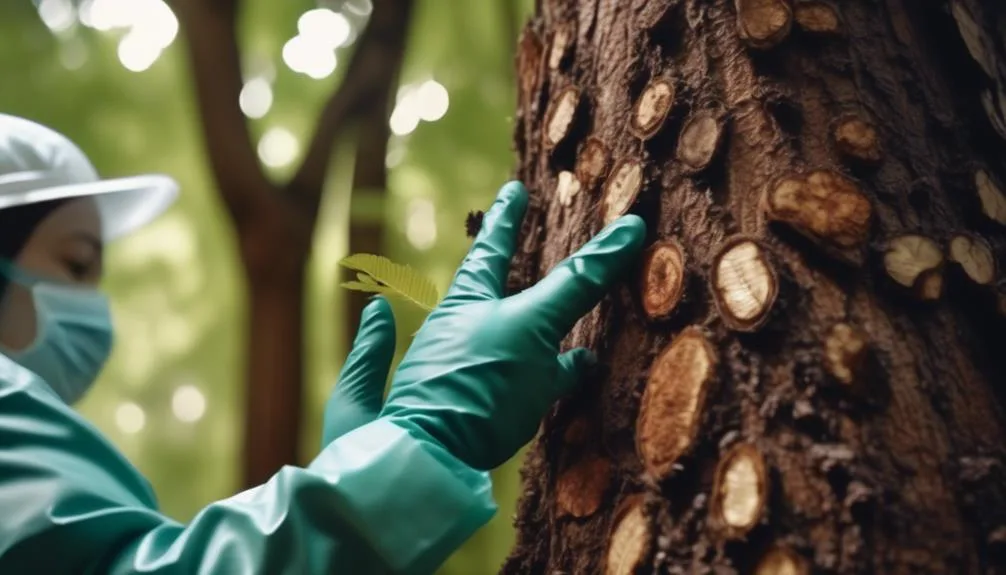As you gaze at your towering redwood trees, you might spot signs of disease. But don't worry, there are natural ways to handle redwood tree diseases.
From spotting common issues to using organic solutions and maintaining soil health, there's a lot to learn.
Let's explore managing redwood tree diseases together to keep these magnificent giants healthy for years to come.
Identifying Redwood Tree Diseases
To identify redwood tree diseases, closely observe the foliage, bark, and overall tree health for any signs of discoloration, lesions, or unusual growth patterns. Regular tree inspection is crucial in catching potential issues early.
Fungal infections are a common problem for redwood trees. Look for any black or brown spots on the leaves, which could indicate a fungal infection. Additionally, check for any powdery mildew on the foliage, as this is another common symptom of fungal diseases.
Inspect the bark for any signs of rot, especially around the base of the tree. Any unusual growth patterns such as deformed leaves or stunted growth should also be noted.
Organic Disease Prevention Methods
As you inspect your redwood trees for any signs of disease, it's important to implement organic disease prevention methods to ensure their long-term health and vitality.
One crucial aspect of organic disease prevention is effective pest control. Regularly inspect your trees for pests like aphids, mites, or scale insects, and use natural predators or insecticidal soaps to keep their populations in check. Additionally, maintaining a healthy and balanced ecosystem around your redwood trees can help to naturally deter pests.
Another key aspect of organic disease prevention is managing fungal infections. Ensure proper spacing between trees to promote good air circulation and reduce the likelihood of fungal diseases. Also, avoid overhead watering and instead water the soil directly to prevent moisture from accumulating on the tree's foliage, which can create a favorable environment for fungal growth.
Natural Remedies for Redwood Tree Diseases
When addressing redwood tree diseases, consider using natural remedies to effectively manage and treat any issues that may arise.
Herbal remedies can be a powerful tool in combating fungal infections, which are common culprits in redwood tree diseases. For example, neem oil, derived from the seeds of the neem tree, has antifungal properties and can help control diseases like powdery mildew.
Additionally, garlic and chamomile tea sprays can act as natural fungicides, providing a gentle yet effective treatment for fungal infections.
These herbal remedies work in harmony with the environment and can help maintain the overall health of redwood trees without the use of harsh chemicals.
Maintaining Soil Health for Disease Resistance
Incorporating natural remedies into your redwood tree care routine not only helps combat fungal infections but also lays the foundation for maintaining soil health, essential for building disease resistance in redwood trees.
Improving fertility and building biodiversity are crucial aspects of maintaining soil health. You can enhance soil fertility by adding organic matter such as compost or well-rotted manure. This not only provides essential nutrients for the trees but also fosters a healthy ecosystem of beneficial microorganisms in the soil.
Additionally, promoting biodiversity by planting a variety of ground covers and companion plants helps create a balanced and resilient soil environment.
Monitoring and Managing Redwood Tree Diseases
To effectively monitor and manage redwood tree diseases, regularly inspect your trees for any signs of discoloration, lesions, or unusual growths. This proactive approach is crucial for maintaining tree health and detecting diseases early.
Keep an eye out for any abnormal changes in the foliage, such as yellowing, browning, or spots. Additionally, check for any unusual bulges or growths on the trunk and branches.
Conclusion
Incorporating these organic methods will help maintain the strength and vibrancy of your redwood trees. This will ensure their continued thriving in their natural environment. By identifying diseases early and using natural remedies, you can address any issues that may arise. Additionally, nurturing healthy soil is crucial for the overall health of your redwood trees. By providing them with the proper nutrients and a supportive environment, you can help them grow and thrive. With these techniques, you can enjoy the enduring beauty of your redwood trees for years to come.

My interest in trees started when I first saw the giant sequoias in Yosemite.
I was a teenager then, and I remember thinking, “I need to learn more about this.”
That moment stuck with me.
A few years later, I went on to study forestry at Michigan Tech.
Since graduating, I’ve worked in a mix of hands-on tree care and community education.
I’ve spent over ten years helping people understand how to plant, maintain, and protect the trees in their neighborhoods.
I don’t see trees as just part of the landscape.
They are living things that make a real difference in our daily lives.
